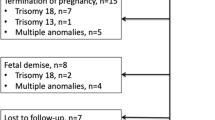Abstract
Objective
To evaluate the optimal approaches to initial surgical management and the potential for prenatal ultrasound detection of patients with closing gastroschisis.
Study design
We performed a retrospective analysis of patients born with gastroschisis to determine clinical and surgical outcomes and the ability to determine prognosis by prenatal imaging. Data collected included operative findings and postoperative outcome, as well as prenatal imaging features from a subset of cases with and without closing gastroschisis. Statistical analyses were performed as appropriate.
Results
We included 197 patients with gastroschisis. No statistical significance was seen in outcomes between closing gastroschisis patients undergoing resection versus intracorporeal parking (n = 18). Ultrasound review was performed on 33 of these patients, 11 with closing gastroschisis, and 22 without. Significantly more closing gastroschisis patients had imaging indicative of progressive defect narrowing and defect diameter ≤8 mm after 30 weeks of gestation versus non-closing patients (p = 0.002).
Conclusion
Parking of extruded bowel offers potential for intestinal remodeling. In addition, prenatal ultrasound may be useful in detection of closing gastroschisis in utero.
This is a preview of subscription content, access via your institution
Access options
Subscribe to this journal
Receive 12 print issues and online access
$259.00 per year
only $21.58 per issue
Buy this article
- Purchase on Springer Link
- Instant access to full article PDF
Prices may be subject to local taxes which are calculated during checkout


Similar content being viewed by others
References
Abdel-Latif M, Soliman MH, El-Asmar KM, Abdel-Sattar M, Abdelraheem IM, El-Shafei E. Closed gastroschisis. J Neonatal Surg. 2017;6:61.
Davenport M, Haugen S, Greenough A, Nicolaides K. Closed gastroschisis: antenatal and postnatal features. J Pediatr Surg. 2001;36:1834–7.
Sydorak RM, Nijagal A, Sbragia L, Hirose S, Tsao K, Phibbs RH, et al. Gastroschisis: small hole, big cost. J Pediatr Surg. 2002;37:1669–72.
Perrone EE, Olson J, Golden JM, Besner GE, Gayer CP, Islam S, et al. Closing gastroschisis: the good, the bad, and the not-so ugly. J Pediatr Surg. 2019;54:60–4.
Bergholz R, Boettcher M, Reinshagen K, Wenke K. Complex gastroschisis is a different entity to simple gastroschisis affecting morbidity and mortality- a systematic review. J Pediatr Surg. 2014;49:1527–32.
Carnaghan H, Pereira S, James CP, Charlesworth PB, Ghionzoli M, Mohamed E, et al. Is early delivery beneficial in gastroschisis? J Pediatr Surg. 2014;49:928–33.
Estrada JJ, Petrosyan M, Hunter CJ, Lee SL, Anselmo DM, Grikscheit TC, et al. Preservation of extracorporeal tissue in closing gastroschisis augments intestinal length. J Pediatr Surg. 2008;43:2213–5.
Emil S, Canvasser N, Chen T, Friedrich E, Su W. Contemporary 2-year outcomes of complex gastroschisis. J Pediatr Surg. 2012;47:1521–8.
Davis RP, Treadwell MC, Drongowski RA, Teitelbaum DH, Mychaliska GB. Risk stratification in gastroschisis: can prenatal evaluation or early postnatal factors predict outcome? Pediatr Surg Int. 2009;25:319–25.
Hijkoop A, IJsselstjn H, Wijnen RMH, Tibboel D, van Rosmalen J, Cohen-Overbeek TE. Prenatal markers and longitudinal follow up in simple and complex gastroschisis. Arch Dis Child: Fetal Neonatal. 2018;103:126–31.
Geslin D, Clermidi P, Gatibelza ME, Boussion F, Saliou AH, Dove GLM, et al. What prenatal ultrasound features are predictable of complex or vanishing gastroschisis? A retrospective study. Prenat Diagnosis. 2016;37:168–75.
Gelas T, Gorduza D, Devonec S, Gaucherand P, Downham E, Claris O, et al. Scheduled preterm delivery for gastroschisis improves postoperative outcome. Prediatric Surg Int. 2008;24:1023–9.
Funding
Funding for this project was provided by Meharry Medical College as a part of their Medical Student Research Experience Program.
Author information
Authors and Affiliations
Contributions
Study conception and design by ADM, HNL, NMN, and LCZ. Acquisition of data by ADM and JF. Analysis and interpretation of data by BL, HNL, NMN, SZ, and LCZ. Drafting of manuscript by JF. Critical revision of manuscript by HNL, NMN, and LCZ.
Corresponding author
Ethics declarations
Conflict of interest
The authors declare no competing interests.
Additional information
Publisher’s note Springer Nature remains neutral with regard to jurisdictional claims in published maps and institutional affiliations.
Supplementary information
Rights and permissions
About this article
Cite this article
Field, J.P., Zuckerwise, L.C., DeMare, A.M. et al. Identifying prenatal ultrasound predictors and the ideal neonatal management of closing gastroschisis: the key is prevention. J Perinatol 41, 2789–2794 (2021). https://doi.org/10.1038/s41372-021-01006-9
Received:
Revised:
Accepted:
Published:
Issue Date:
DOI: https://doi.org/10.1038/s41372-021-01006-9


